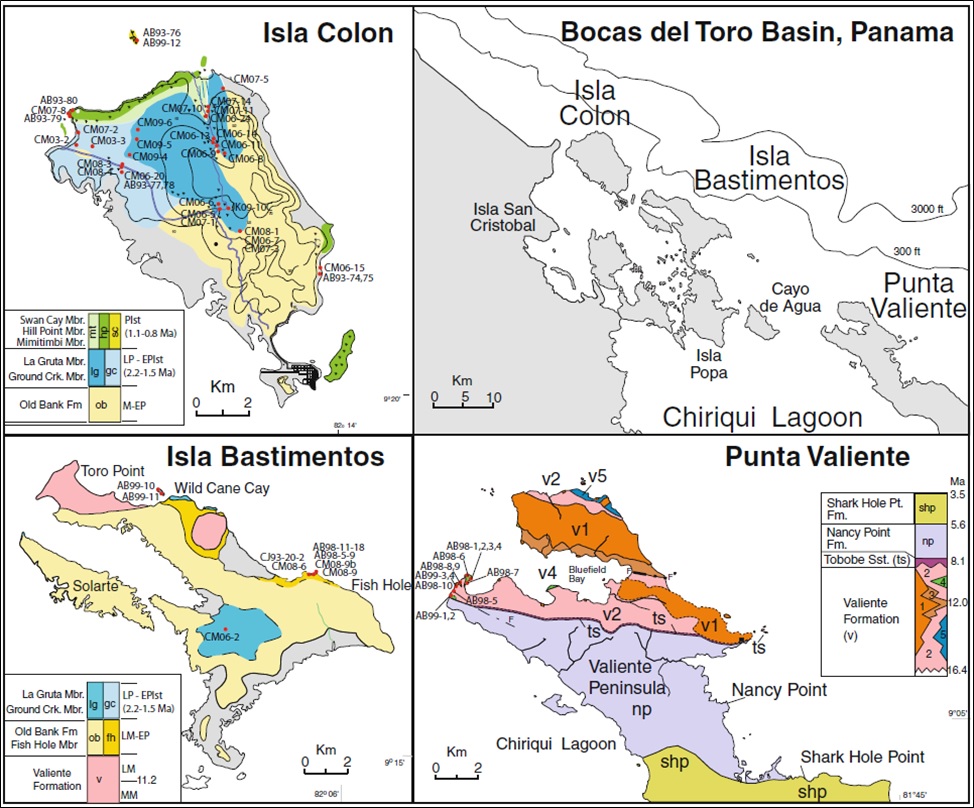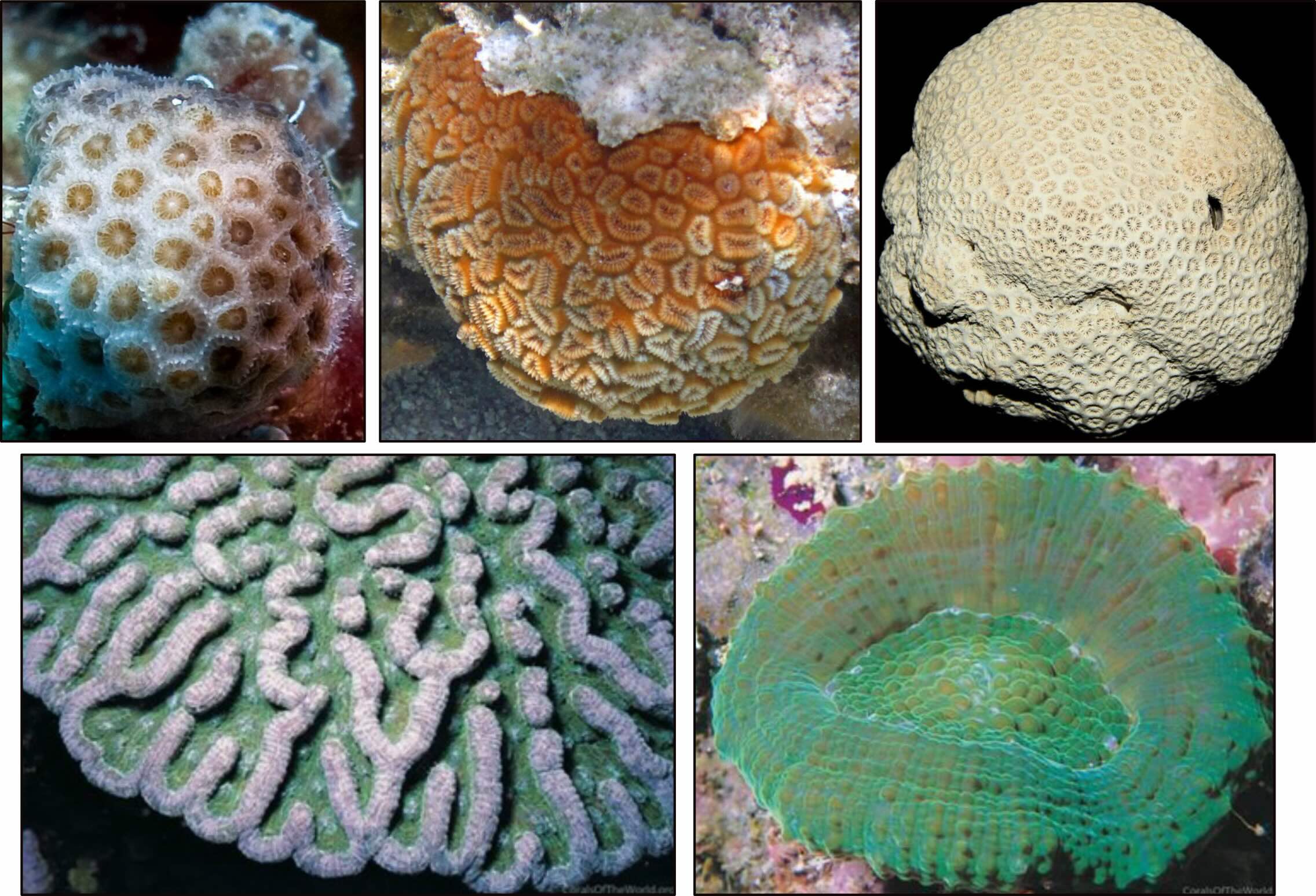Urraca Fm
Type Locality and Naming
The Swan Cay was named by Coates (1999) and given the status of “Formation” for the small island of the same name that lies 1.7 km off the north coast of Colon Island (Figure 042). Later, Klaus et al. (2012) changed its status to a Member of the Urraca Fm, named after a private island. The stratotype (Section 25 of Coates (1999)) is the section that runs from north (youngest) to south (oldest) across Swan Cay Island. No other sections of the Swan Cay Member have been observed.
[Figure 042. Bocas del Toro archipelago, NW Panama with map of the western & central portion together with the geological maps of Isla Colon, Isla Bastimentos, Punta Valiente (Klaus et al. (2012)) and Popa Island (Coates et al. (2005)).]
Synonym: Swan Cay Fm (for Swan Cay Member) . Coates (1999); Klaus et al. (2012); It is suspected that “Mimitimbi Member” is the equivalent of Terry (1956)’s “Minitimi Limestone”.
Lithology and Thickness
The Mimitimbi Member is exposed along the banks of the Mimitimbi River on the northeastern coast of Colon Island (Figure 042). The unit is marked by abundant corals (Figure 155) and skeletal debris admixed with carbonate and siliciclastic mud. The unit consists of alternating coral-rich beds and muddy siliciclastic beds at its base and transitions up-section to a series of shallowing-upward burrowed-crossbedded units of carbonate sand.
The Hill Point Member occurs along the southeast coast of Colon Island as well as along the north coast as a series of pinnacle-barrier reefs (Figure 042). These shallow reef units correlate with deeper fore-reef deposits found on Swan Cay north of Colon Island.
Swan Cay Member (79m): The Member has three components. The lower 15 m is exposed on the southerly low hill of the island and consists of silty sandstone and shelly calcarenitic siltstone, with coral rubble and red algal fragments and balls. The middle 4 m consists of calcarenitic clayey siltstone, with dense, fine shellhash horizons, and abundant large coral colonies in the lower part. The upper 60 m of the formation consists of massively thick-bedded, pale tan-white calcarenite. The upper 30 m are vuggy, sparry, and clean and include a 4-m-thick coral bed with large Montastraea colonies, other corals and mollusks. The lower 30 m consist of more silty calcarenite with common red algae and large foraminifera, shell hash, and micromollusks. This limestone also shows evidence of frequent microfracturing, many of which are healed with secondary calcite cement. Cave deposits, about 5 m above the base of the calcarenite, consist of silty, shelly, volcaniclastic sandstone, mixed with abundant volcanic cobbles and boulders, and calcareous reef rubble containing an abundant and diverse molluscan assemblage. Coates (1999) & Coates et al. (2005).
Based on stratigraphic relationships, the Mimitimbi Member is slightly older than the Hill Point Member.
Relationships and Distribution
Lower contact
Upper contact
Regional extent
The Hill Point Member occurs along the southeast coast of Colon Island as well as along the north coast.
The Swan Cay Member runs from north (youngest) to south (oldest) across Swan Cay Island. No other sections of the Swan Cay Member have been observed.
GeoJSON
Fossils
Figure 155. Modern day equivalent of common Neogene coral species from the Urraca Fm (Mimitimbi Member) that Klaus et al. (2012) recovered from the Bocas del Toro region of Panama. Top (left to right) - Madracis pharensis, Dichocoenia stellaris, Stephanocoenia spongiformis. Bottom (left to right) - Mycetophyllia danaana, Scolymia cubensis. From www.coralsoftheworld.org, www.wikipedia.org, and www.ebay.com
Age
Depositional setting
The Hill Point Member is the middle Member of the Urraca Fm and occurs along the southeast coast of Colon Island as well as along the north coast as a series of pinnacle-barrier reefs (Figure 042). These shallow reef units correlate with deeper fore-reef deposits found on Swan Cay north of Colon Island.
Additional Information
References:
Coates (1999); Collins et al. (1999a & 1999b); Coates et al. (2005); Kiessling et al. (2011); Landau et al. (2012d) ; Schwarzhans et al. (2016).

